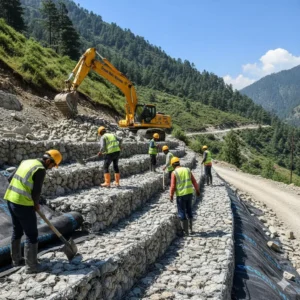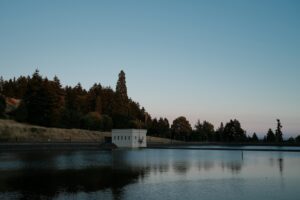Case Study: Ensuring Environmental Safety in Varanasi’s Landfill Project with Ocean Non Wovens’ Geosynthetic Solutions
Introduction
Landfills, when not properly designed and managed, pose significant environmental risks, including groundwater contamination, soil degradation, and air pollution. To mitigate these risks, advanced geosynthetic materials are crucial. Ocean Non Wovens, a leading geosynthetics manufacturer and supplier, recently completed a significant landfill project in Varanasi, Uttar Pradesh. The project involved the use of Ocean Geosynthetics Clay Liner-5MM, Ocean Non Woven Geotextile PP 3.5 MM thickness, and Ocean HDPE Liner-1500 Micron, each covering an area of 17,250 sqm.
Table of Contents
Project Overview
The Varanasi landfill project was designed to handle a significant volume of municipal solid waste while ensuring minimal environmental impact. The primary challenge was to create a robust containment system that would prevent leachate—a potentially hazardous liquid formed by waste decomposition—from seeping into the surrounding soil and groundwater. To achieve this, Ocean Non Wovens supplied and installed three critical geosynthetic products:
1. Ocean Geosynthetics Clay Liner-5MM
2. Ocean Non Woven Geotextile PP 3.5 MM Thickness
3. Ocean HDPE Liner-1500 Micron
Each of these products played a vital role in the landfill’s containment system, ensuring long-term environmental protection and regulatory compliance.
Ocean Geosynthetics Clay Liner-5MM: The Foundation of Containment
The Ocean Geosynthetics Clay Liner-5MM served as the primary barrier in the landfill containment system. This liner is composed of high-quality bentonite clay, which has an exceptional ability to swell when in contact with water, creating a low-permeability barrier. This property makes it an ideal material for preventing leachate migration.
In the Varanasi landfill project, the clay liner was installed as the first layer in the containment system. Its primary function was to provide a base layer that would absorb any initial leachate and prevent it from reaching the underlying soil. With a thickness of 5MM, the clay liner offered a strong yet flexible barrier, capable of withstanding the pressures exerted by the waste above it.
Ocean Non Woven Geotextile PP 3.5 MM: Enhancing Filtration and Drainage
Above the clay liner, Ocean Non Wovens installed their Ocean Non Woven Geotextile PP 3.5 MM thickness. This geotextile layer played a dual role in the containment system: filtration and drainage.
As a filtration layer, the geotextile prevented fine soil particles from clogging the drainage system, ensuring that leachate could be effectively managed and directed to designated collection points. This function is crucial in maintaining the integrity of the landfill, as blocked drainage can lead to water accumulation, increasing the risk of liner failure.
In its drainage capacity, the geotextile facilitated the flow of leachate towards the drainage pipes, ensuring that any liquid passing through the clay liner could be efficiently collected and treated. The 3.5 MM thickness of the geotextile provided a robust yet permeable layer, capable of withstanding the weight of the waste while maintaining its filtration and drainage properties.
Ocean HDPE Liner-1500 Micron: The Final Barrier
The final layer in the containment system was the Ocean HDPE Liner-1500 Micron. High-Density Polyethylene (HDPE) is a highly durable and chemically resistant material, making it ideal for landfill applications where exposure to harsh chemicals and extreme conditions is expected.
The HDPE liner served as the final impermeable barrier, preventing any remaining leachate from escaping into the environment. Its 1500-micron thickness provided exceptional puncture resistance, ensuring that the liner would remain intact even under the heavy loads of waste.
In addition to its strength, the HDPE liner offered excellent chemical resistance, protecting against the wide range of contaminants that could be present in the landfill. This resistance is critical for maintaining the long-term integrity of the containment system, ensuring that the landfill remains secure for decades.
Unique Insights: The Unseen Challenges and Solutions
While the installation of geosynthetics in landfills may seem straightforward, several challenges often go unnoticed. One such challenge is the potential for differential settlement—a situation where different parts of the landfill settle at different rates, potentially causing stress on the liners. In the Varanasi project, Ocean Non Wovens addressed this by carefully selecting materials with high flexibility and tensile strength, capable of accommodating minor shifts without compromising the containment system.
Another critical consideration is the interface shear strength between different layers of geosynthetics. A lack of proper adhesion can lead to slippage between layers, reducing the overall effectiveness of the containment system. To prevent this, Ocean Non Wovens ensured that the surface properties of the clay liner, geotextile, and HDPE liner were compatible, allowing for strong interlayer bonding and reducing the risk of slippage.
Finally, the installation process itself can be a challenge, particularly in large-scale projects like the Varanasi landfill. Ocean Non Wovens employed skilled technicians and advanced equipment to ensure that each layer was installed with precision, minimizing the risk of damage during installation.
Conclusion: Promoting Environmental Sustainability with Ocean Non Wovens
The successful completion of the Varanasi landfill project stands as a testament to Ocean Non Wovens’ commitment to environmental sustainability and innovation in geosynthetics. By providing high-quality materials and expert installation, Ocean Non Wovens ensured that the landfill would remain secure, protecting the surrounding environment for generations to come.
As a leading geosynthetics manufacturer and supplier, Ocean Non Wovens is dedicated to providing solutions that not only meet regulatory requirements but exceed industry standards. Our products are designed to withstand the most challenging conditions, ensuring long-term performance and environmental safety.
For more information on how Ocean Non Wovens can support your next landfill project, or to learn about our full range of geosynthetic solutions, visit our website or contact our team of experts today. Let’s work together to build a safer, more sustainable future.



